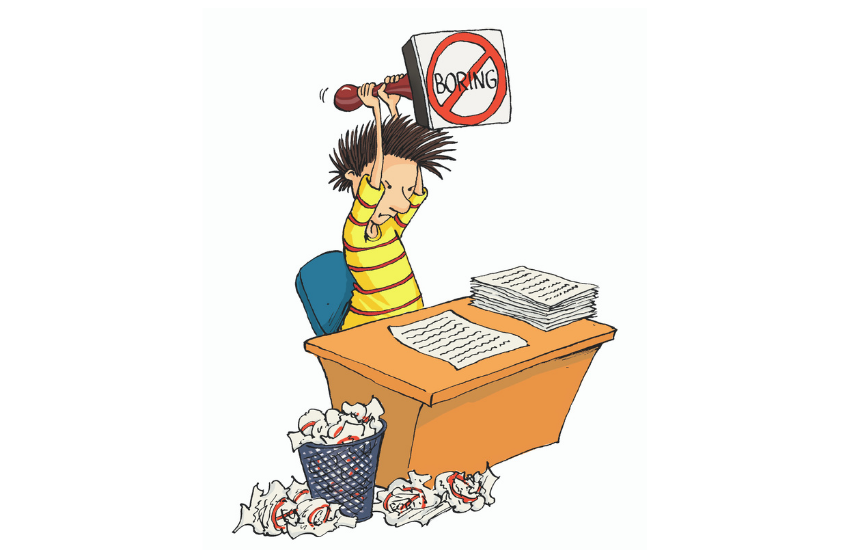After implementing Steps 1–5, there should already be far fewer boring bits in your students’ writing! Therefore a powerful application of Step 6: Ban the Boring is that it can be used as an editing tool AFTER writing.
Say the word ‘editing’ to students and they groan. Say it to authors and they smile.
Authors know that the first draft is the ‘down and dirty’ draft. They look forward to editing, knowing that it will add richness and improve the flow of their writing. Students, on the other hand, think editing is just fixing the spelling and grammar. This doesn’t improve the impact of their writing significantly, so they find it boring.
Three types of editing
As an author there are three types of editing I do before submitting a manuscript – and this is before the editors have their input!

1. Structural editing
This is the big picture, ‘heavy lifting’ editing and the most interesting part of the revision process. When the whole novel is drafted, I go through the first draft to make sure that the story:
- follows the Story Graph
- has a Sizzling Start
- is fast-paced
- builds up tension using the pebble, rock, boulder approach
- includes a fabulous tension (boulder) scene that has my readers on the edge of their seats!
- ends with impact
Sometimes at this stage I ditch whole paragraphs or whole pages to make the writing better.
2. Expression editing
This is where I reword sentences or paragraphs in order to say things in a better, richer or more powerful way.
The word count doesn’t actually change much, but the pace and emotional flow of the story becomes far more engaging.

3. Secretarial editing
In a publishing house, this is known as line editing. It is the functional part of editing; finding typos, grammatical errors, spelling mistakes and even additional spaces between words. I would rather read the phone book than try to find these sort of mistakes in my writing and yet this is what most students think of when you mention editing.
| [Related blog]: Should I correct the spelling? |
Putting this into practice
Familiarise students with all three stages of the editing process and stress the importance of structural editing. Try using the Seven Steps terminology at this first editing stage to provide feedback and see how students can radically improve their writing. For example:
Before
One day there was a fish called Fins. Fins lived in a place called Peaceful Village. Fins was playing peacefully with his school when suddenly some fishermen came. They brought their boats around and around the other side. They were trapped! The fish were getting caught in the nets around Fins. He managed to see a little gap between the boats and he got away.
Feedback
Luke has started his story right in the middle of the action which is great! However, as readers, we don’t feel like we are really there. To Ban the Boring and make the opening more dramatic, Luke could:
- Add more detail to Tighten Tension – don’t just say the boats came. Close your eyes and think of what the fish would see, hear, touch, taste, smell and feel (the Five + 1 Senses). There would be engine noises and shouting, nets and danger. Fins would hear his friend’s cries for help. He’d taste their blood in the water.
Imagine what it would be like to be there using all of the senses and then weave those details into the writing.
[Related download]: Step 3 Tightening Tension Lesson Plan: Five + 1 Senses - Use Dynamic Dialogue to bring the scene to life – Don’t just write ‘the fish were frightened and the leader called out to follow him’. Put in the actual words they would say. ‘Hurry!’ ‘This way.’ ‘Quickly!’ Hearing the real words has much greater impact.
[Related Article]: 188 words for SAID – but should you use them?
After
The fishermen came when Fins was playing peacefully with his school. They brought their boats and nets and noise. And danger.
‘Quickly!’ cried the leader. ‘Swim this way.’
But the nets were already there.
‘The other way!’ someone called. ‘Hurry!’ Some of the school were already caught in the nets. The water churned as they struggled. Fin could hear their cries, he tasted their blood in the water.
He swam quickly. There was a gap at the side of the nets. He swam towards it sideways.
‘Quickly now! Hurry!’
And suddenly he was free.
Using the Five + 1 Senses (tension activity) and putting in dialogue, makes this scene much more dramatic. It is easy to do using the Seven Steps techniques.
The good news is that you won’t have to do this long term. If you train students in these editing skills, soon they will be able to edit their own work and the ‘boring bits’ will disappear forever!

Ban the Boring Action Activity
Get students to read the ‘Before’ version of Fins the Fish and then in groups make suggestions using the Seven Steps to improve the text. Show students the feedback in the blog post for comparison.
Challenge students to edit the text individually using the suggestions before sharing the ‘After’ version and some of the examples written by students.
The Seven Steps Master Marking Sheet is a simple template for marking students’ writing.
Access more Ban the Boring Action Activities, writing samples and the complete Seven Steps ‘Narrative Marking Guide’ with a Teacher Hub subscription.

Become a Seven Steps member


